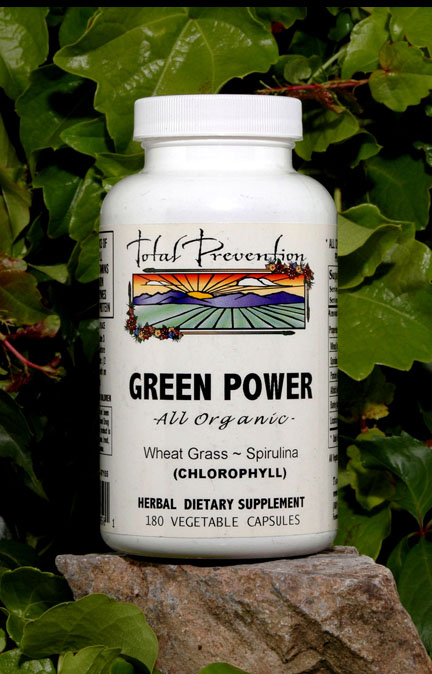Green Power
The Most Complete Nutritional Whole Food From the Earth
Receive the important nutrients from plants from their natural state. No pesticides or chemicals. All organic in it's purest form. Naturally filled with VITAMINS, MINERALS, PROTEIN, AMINO ACIDS and ENZYMES.
TRY GREEN POWER AND FEEL THE DIFFERENCE!
CONTAINS: Wheatgrass, Parsley, Barley, Alfalfa, Spirulina & Licorice
WHEATGRASS A rich nutritional green food, which is a very high source of chlorophyll, Vitamins C, E, B, and E, minerals, amino acids, protein, and enzymes. It contains potassium, calcium, zinc, magnesium, manganese, chromium, selenium, iron and phosphorus. Wheatgrass is known as the alternative cancer therapy, it helps your body build red blood cells which carry oxygen to every cell.
PARSLEY Parsley contains more Vitamin C by weight than oranges. An excellent source of Vitamin A and Trace Minerals. Scientists have found that it has a substance that prevents the multiplication of tumor cells. Some even think that it may yet be proven that parsley is a cancer preventive!
BARLEY Barley is a superior source of chlorophyll which is similar to human blood, and a very high source of vitamins, minerals, and protein. Barley provides 30 times more Vitamin B1 and Calcium than milk, 7 times more Vitamin C than oranges, and nearly 5 times the iron of spinach. It is known as a Powerful Antioxidant which protects cells against toxic free radicals.
ALFALFA Alfalfa is very high in vitamins, minerals and protein. It alkalizes the body. It acts as a diuretic, eases inflammation, lowers cholesterol, balances hormones, and promotes pituitary gland function. It is good for anemia, bleeding related disorders, bone and joint disorders, colon and digestive disorders, skin disorders, and ulcers.
SPIRULINA Spirulina is known as the b- 70% protein which is 95% digestible compared to 20% from meat protein. It is a blue-green algae that is a very rich source of beta carotene, which has been shown to reduce health risks. Rich in essential amino acids, iron, Vitamin B-12, chlorophyll and calcium. It has the essential fatty acid GLA (Gamma-linolenic acid), only found in mothers breast milk. Spirulina naturally includes a powerful antioxidant called phycocyanin.
LICORICE Used as a herbal transporter to deliver the nutrients through the body - enhances circulation. It helps promote and support the adrenal glands. Licorice is a very high source for magnesium, silicon, chromium, iron, niacin, and Vitamin C.
Why Wheatgrass?
It is easy to control your own food supply and take responsibility for one's health. Time has shown that our battles against degenerative and chronic diseases like cancer, heart disease, diabetes, arthritis and others cannot be won by the palliative measures like surgery, chemotherapy, and other medical intervention, but only through prevention. Unfortunately, more people wait until there is a critical problem to give preventive action a thought, and then it becomes a question of preventing a recurrence. But true prevention stops a problem before there is any serious permanent damage. The fact is survival is not only possible but joyous. It is the re-inheritance of our natural birthright-health-which has been stripped from us by modern man's errors in judgement. Ann Wigmore, Boston, 1984.
What is Wheatgrass?
Wheatgrass is one of the so-called green foods that are valued by health-conscious people as a great natural source of nutrients. The tender young blades of the wheat plant contain a high source of vitamins, minerals, enzymes, amino acids and chlorophyll. It is considered to be a complete food in itself, by the fact that one pound of wheatgrass is equivalent in nutritional value to 23 pounds of choice garden vegetables.
Help With Disease?
Wheatgrass is known as an alternative cancer therapy. It helps your body to build red blood cells which carry oxygen to every cell. By increasing the oxygenation in the body you can help offset disease and increase your endurance levels, (cancer and other diseases cannot live in an oxygen environment).
Vitamin's & Minerals
To get the most benefit from vitamins and minerals, they should be consumed in a form as close to a natural state as possible. Unfortunately, many fruits and vegetables today are often nutrient deficient due to repetitive plantings sometimes spanning many generations, and they are sprayed with many chemicals and pesticides. We are not getting the good nutrients that we think we are getting. Wheatgrass is high in Vitamin C, A, E, and B. Wheatgrass has more Vitamin C than oranges and twice the vitamin A as carrots. It has more than 90 minerals which are needed to maintain a good metabolism. The presence of these alkaline minerals is found in wheatgrass and contains calcium, magnesium, potassium and iron, a mineral essential for transporting oxygen to the lungs. Organic sodium is also found aiding in digestion and regulating the amount of fluids in the body.
Enzymes
Enzymes are an important active ingredient in wheatgrass. They are the life force of our foods and are needed to carry out many important biological and chemical functions. Wheatgrass contains the following enzymes to name just a few
- Protease - assists in protein digestion
- Cytrochrome Oxidase - an antioxidant used for proper cell respiration
- Amylase - facilitates starch digestion
- Lipase - a fat splitting enzyme
- Transhydrogenase - helps keep muscle tissue of the heart toned
Amino Acids
This nutrient contains 17 amino acids which are the building blocks of proteins. They are used for building the body, muscle tissue, repairing cells, and clotting the blood. Wheatgrass is a complete protein. In addition to the essential amino acids it also contains alanines - a blood purifier; asparatic acid - converts food to energy; glutamic acid - improves mental balance; arginine - found in large quantities is seminal fluid; and serine - stimulates brain and nerve function.
Chlorophyll
Wheatgrass is 70% Chlorophyll, which closely resembles hemoglobin, the protein of red blood cells. It is the basis of all plant life, high in oxygen. It helps brain and all body tissues function at an optimal level in a high oxygen environment. Science has proven that chlorophyll arrests growth and development of unfriendly bacteria.
What is Parsley?
Parsley is a small dark green plant with curly divided leaves. It is known as a dinner plate garnish whose use is not only ornamental, but is also used as an after dinner breath mint to reduce mouth odors.
Uses
Parsley contains aromatic compounds that decrease the thickness and increase the production of mucosal fluids, increase the production of digestive fluids and urine flow. It also contains bitter compounds that reduce muscle spasms and pains, reduce blood pressure and are antiseptic. It is a great cleansing herb, benefitting the lungs, stomach, liver and thyroid.
Vitamin's & Minerals
It is full of nutrients that help give it the name of one of natures preventive medicines. It is high in Vitamin B, A, & C. Parsley is an excellent herbal source of trace minerals, especially the electrolyte minerals including sodium, potassium, calcium and magnesium.
Help with Disease?
Parsley contains a substance that has been know to prevent the multiplication of tumor cells, expel worms, relieve gas, stimulate normal activity of the digestive system, and freshen breath. Helps bladder, kidney, liver, lung, stomach, and thyroid function. Good for bed-wetting, fluid retention, gas, halitosis, high blood pressure, indigestion, kidney disease, obesity, and prostate disorders.
Chlorophyll
Chlorophyll is abundant in parsley. Chlorophyll closely resembles hemoglobin, the protein of red blood cells. Chlorophyll is the basis of all plant life, high in oxygen. It helps brain and all body tissues function at an optimal level in a high oxygen environment. Science has proven that chlorophyll arrests growth and development of unfriendly bacteria.
What is BARLEY GRASS?
Barley Grass is one of the most nutritionally concentrated sources of dark green leafy vegetables found.
Helps with Disease?
Barley grass is known to heal stomach, duodenal, and colon disorders as well as pancreatitis, and is an effective anti-inflammatory. A biologist named Yasuo Hottaq from the University of California, La Jolla, found in barley grass a substance called P4D1. This substance not only has strong anti-inflammatory action but was shown to actually repair the DNA in the cells of the body. This aided in the prevention of carcinogenesis, aging, and cell death. He reported in a Japan Pharmacy Science Association meeting that P4D1 suppresses or cures pancreatitis, stomatitis, inflammation of the oral cavity, and dermatitis, and also lacerations of the stomach and duodenum. He found that barley grass is much stronger than steroid drugs but has fewer if any side effects.
Dr. Howard Lutz, who is director of the Institute of Preventive Medicine in Washington, D.C., has said this about barley grass: "(Barley grass is) one of the most incredible products of this decade. It improves stamina, sexual energy, clarity of thought, and reduces addiction to things that are bad for you. It also improves the texture of the skin, and heals the dryness associated with aging."
WEIGHT LOSS
Many people have claimed that regular supplementation with green barley grass stimulates weight loss, which research says is due to the enhancement of the cytochrome oxidase enzyme system which is essential for cell metabolism.
ARTHRITIS
People with arthritis have used celery juice for years because of the organic sodium it contains. According to Hagiwara, in his book, Green Barley Essence, barley grass has 775 mg. Organic sodium per 100 grams. This contracts with 28 mg. Sodium per 100 grams in celery. Organic sodium keeps calcium in solution in the bloodstream and also dissolves calcium deposited on the joints. (For this reason alone, it should be very calming to the nerves.) It also replenishes organic sodium in the lining of the stomach. This aids digestion by improving the production of hydrochloric acid in the stomach.
Vitamin's & Minerals
Barley grass is the most excellent source of nutrients that the body needs for growth, repair and well being. It is high in calcium, iron, all the essential amino acids, chlorophyll, flavonoids, vitamin B12, vitamin C, and many minerals and enzymes. Barley Grass has 30 times as much vitamin B1 as in milk, 3.3 times as much vitamin C, and 6.5 times as much carotene (Vitamin A) as in spinach, 11 times the amount of calcium in cow's milk, nearly five times the iron content of spinach, nearly seven times the vitamin C in oranges, four times the vitamin B1 in whole wheat flour, and 80 micrograms of vitamin B12 per 100 grams of dried barley. (Analysis done by Resource Research Association, Office of Science and Technology, and Japan Food Analysis Center).
Amino Acids & Protein
It contains the eight essential amino acids that we must get from our diet. Amino acids are the building blocks of proteins, which are the major constituents of every cell and body fluid (except urine and bile) and are thus necessary for the continual cell building, cell regeneration, and energy production that we need for life. An added benefit of the green barley grass leaf proteins is that they are polypeptides - smaller proteins that can be directly absorbed by the blood where they promote cell metabolism (the chemical changes that we need to live) and neutralize substances that are bad for our health.
Enzymes
Green Barley leaves contain a multitude of the body's spark plugs, enzymes. Enzymes supply the spark that starts the essential chemical reactions our bodies need to live. Without this spark, and these chemical reactions, we would be helpless, unable to walk, talk, blink or breathe. Another enzyme contained in barley grass is superoxide dismutase (SOD), a powerful antioxidant which protects the cells against toxic free radicals which are thought to be a primary culprit in aging and many other diseases.
ALFALFA
Called the "Queen of Forages" alfalfa is not only the oldest cultivated forage crop in the US, but it is one of the most palatable and nutritious. And, when cut prior to bloom, it is low in fiber and high in energy.
Vitamin's & Minerals
Alfalfa is rich in protein, vitamins, and minerals, especially Vitamin A, K, C, Riboflavin (B2), and Iron.
Helps With Disease
Used for Allergies, Arthritis, Asthma, Bells Palsy, Blood Disorders, Bursitis, Cholesterol, Diabetes, Digestive Disorders, Fatigue, Gout, Lactation, Kidney Disorders, Morning Sickness, Rheumatism, Tissue Damage, Ulcers, and Urinary tract infections.
Uses
Alfalfa is highly esteemed in folk medicine as a cure for all inflammations including arthritis and rheumatism. It neutralizes uric acid in cases of arthritis. It is widely used as a blood purifier, and aids in digestion. Used for water retention, has a beneficial effect of the pituitary gland, aids in preventing cholesterol build up in the veins, and is a good acid balancer. The high beta-carotene content of alfalfa acts to strengthen the epithelial cells of the mucous membranes of the stomach and could be responsible for its reported effects on ulcers. Good nutritional support for alcoholism.
Amino Acids & Protein
Contains all eight essential amino acids, and is a high source of protein.
Chlorophyll
Chlorophyll is abundant in alfalfa. Chlorophyll closely resembles hemoglobin, the protein of red blood cells. Chlorophyll is the basis of all plant life, high in oxygen. It helps brain and all body tissues function at an optimal level in a high oxygen environment. Science has proven that chlorophyll arrests growth and development of unfriendly bacteria.
SPIRULINA
What is Spirulina?
Spirulina is a microscopic blue-green algae, nature’s very own miracle super food. Total Prevention's Spirulina is grown without pesticides or herbicides, and is dried in a few seconds preserving full nutritional value without chemical additives. This super food is not a synthetic laboratory invention. This life form has been renewing itself for more than 3.5 billion years. Today, spirulina is consumed by health conscious people all over the world. If you are moving away from empty processed food and chemical vitamins to natural foods, start using Green Power with spirulina, nature's longest living food. Spirulina is easy to digest so nutrients are absorbed quickly.
High Protein Wonder
Spirulina is 70% protein which is 95% digestible, compared to 20% from meat. It is an easy to digest vegetable protein. People are eating less meat and dairy protein because they want to lower fat, cholesterol, and chemicals in their diet. Spirulina is the highest protein food with all the essential amino acids and has only a few calories to keep your waistline where you want it. It is a higher source of protein than beef, chicken, turkey, eggs, soybeans, rice, tofu or wheat.
World's Highest Beta Carotene Food
Spirulina is a rich source of beta carotene, which has been shown to reduce health risks. It is 20+ times higher in beta carotene than carrots. So even if you don't eat the recommended 4 to 9 servings of fruits and vegetables every day (most people eat only 1-2, including fried french fries), get your natural beta carotene insurance from spirulina to help support your body's defenses.
Rare Essential Fatty Acid - Key to Health
It is the only natural food besides mothers’ milk with the essential fatty acid GLA (gamma-linolenic acid), which helps develop healthy babies.
Iron for Women and Children's Health
Iron is essential to build a strong system, yet is the most common mineral deficiency. Spirulina is rich in iron, magnesium and trace minerals, and is easier to absorb than iron supplements. It is 28 times higher in iron than beef liver, and 56 times higher than spinach or steak.
High in Vitamin B-12
Spirulina is the highest whole food source of Vitamin B-12, essential for healthy nerves and tissue. (Vitamin B-12 is especially important for vegetarians).
Chlorophyll
Chlorophyll is abundant in alfalfa. Chlorophyll closely resembles hemoglobin, the protein of red blood cells. Chlorophyll is the basis of all plant life, high in oxygen. It helps brain and all body tissues function at an optimal level in a high oxygen environment. Science has proven that chlorophyll arrests growth and development of unfriendly bacteria.




